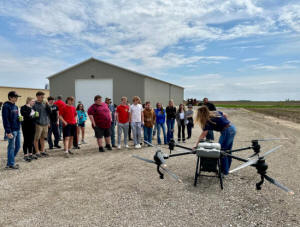|
Japan has been using drone
technology since the turn of the 21st century with satisfying
results. While drones have been offered in America, their use has
been mostly recreational with small machines with still shot cameras
being a popular plaything falling into the category of
remote-control toy trucks or radio operated aircraft flown over open
fields for entertainment purposes only.

One of the first drones we
noted locally in the agricultural industry was owned and operated by
Central Illinois Ag in Atlanta. Even then the use was more as a
marketing tool than an actual research or scouting tool.
According to pilot Abby Coers the first drone they had was very
limited, but today the technology has improved, making drone flying
safer and more reliable regardless of how it is being utilized.
Coers said, “We use the drone just for pretty photos, no decision
making. We got our first drone about 10 years ago when they were
just becoming popular. The camera was a GoPro mounted on to it and
the battery lasted about 8 minutes. We had to use our own timer to
know when the battery was about to die to bring the drone back. Now
the technology has changed so much where if we are flying and the
battery is getting low the drone will ‘return home’ which is the
spot you take off in, for safety reasons. They also have obstacle
avoidance on them so unless that’s turned off it would be very
difficult to fly into anything.”

If you follow CIA on social
media, you may have seen one of their “pretty pictures”, a video of
harvest 2023 from a bird’s eye view
https://www.facebook.com
/reel/254801677580949
In the last two to three years, America has begun to catch up with
countries such as Japan, Korea, China, India, and even Canada.
In Canada, an article published by Modern Farmer on June 19, 2023
added an interesting twist to the evolution of drones in
agriculture. Drone usage is drawing the interest of the female
population and youth on the farm.
Use of drones in field scouting is helping smaller farmers where
that many times scouting for weeds or disease means walking the
fields with a hook and a spray bottle in hand to pull or treat as is
needed. With the use of drones, real time video of the field can
identify trouble spots and drones loaded with spray can be sent to
specific locations for targeted applications.

The use of drones is costly,
but much more cost effective than other agricultural equipment such
as the large spray rigs that are used for full-field applications.
Purchasing a spray drone with a 10-to-13-gallon tank and spare
batteries can run up in $20,000 to $30,000 range with training and
FAA licensing included. This is much less than the hundreds of
thousands of dollars invested in the large spray rigs utilized
mostly by chemical and fertilizer dealerships.
Even so, the price tag may be prohibitive for some producers. On the
other hand, the drones are now starting to enter into the services
offered by those dealerships.

In the spring of 2024 Sun Ag
in Emden offered local high school students a day of education and
demonstration of the use of drones in their business. The two
certified pilots employed by the company spoke to students about how
they are utilizing drones for crop scouting and spot treatment of
fields.
In April 2023 the National Institute of Food and Agriculture, U.S.
Department of Agriculture put its stamp of approval on drone usage
in agricultural settings. They noted drawbacks and barriers along
with noting a healthy list of positives.

“This
project has expanded drone use opportunities by creating new drone
systems that:
“Scout pests and diseases in fruit, nut and row crops and
apply targeted treatment. These industries face major pest issues
that are intensified by limited labor availability and increasing
consumer demand for produce with fewer chemical inputs (Clemson
University, University of Georgia, Purdue University, Washington
State University).
“Monitor plant water stress to help farmers target irrigation
resources where most needed (Clemson University).
“Enable faster plant screening and new types of measurements
and biological discoveries (Montana State University, Texas A&M,
Virginia Tech, Washington State University).
“Detect stray livestock herds, create 3D renderings of
animals to calculate market value and assess forage quality
(University of Kentucky, Mississippi State University).
“Monitor water quality on a large scale (Mississippi State
University, North Carolina State University, Virginia Tech).
“Provide higher resolution data for flood risk models and
water resource management (Auburn University, Mississippi State
University, North Carolina State University, Virginia Tech).”
While that research brought on some very positive results, in
January of 2024, the Ohio State University Extension published an
article that was for the most part “Pro drone” but also listed some
of the challenges and obstacles in the use of drones in agriculture.
[to top of second column]

|

“Acceptance
of spray drones by individual farmers has been slow for several
reasons:
“Since using
drones to spray pesticides is relatively new, the amount of
credible, published research data evaluating spray drone
performance, and comparing drone performance (e.g., efficacy and
spray drift) to ground sprayers and conventional aircraft is very
limited (Li et al., 2020; Li et al., 2021; Biglia, et al., 2022;
Dubuis et al., 2023; Herbst et al., 2023; Huang et al, 2022). Some
of the published data on spray drone performance may not be usable
and can be contradictory because of the wide variation of design
parameters among drones being tested. Additional research and
published data are needed to make conclusive statements about the
performance of drone sprayers compared to conventional aerial and
ground sprayers.
“Fewer acres
are covered per hour of operation compared to airplane and ground
sprayers.
“The battery powering the drone lasts a short time (5–15 minutes
with a full tank) and requires recharging between tank refills.
Having three charged batteries per drone and fast charging at 240v
eliminates long interruptions in spraying to charge the drone’s
battery. Maintaining three charged batteries allows replacement of a
discharged battery while refilling the spray tank. The spent battery
can then be recharged and ready for the next refilling.

“The FAA
(Federal Aviation Administration) imposes several operational
restrictions on drones, such as: a drone must weigh 55 pounds or
less including its payload, the pilot flying the drone must maintain
a visual line of sight with the drone, permission must be obtained
when flying in restricted air space, and drones can be flown only
from 30 minutes before sunrise to 30 minutes after sunset. An FAA
regulation requiring two people to legally operate a spray drone (a
pilot and a visual observer) also results in increased costs.
Perhaps the most severe FAA restriction on spray drones is that an
operator can fly only one drone at a time. Multiple drones operated
by one pilot, defined as “swarming” (Figure 11) is, however,
practiced legally and successfully in other parts of the world,
especially in east Asia—mainly China, South Korea, and Japan. The
FAA is likely to ease this restriction in the near future. Check the
FAA website often to learn current requirements on swarming.
Fortunately, the FAA allows pilots to apply for exemptions for
several of these limitations, such as the 55-pound maximum weight of
the drone sprayer, night spraying, and maintaining a line of sight.
Unfortunately, exemption approvals may take considerable lengths of
time, sometimes even months.”
Adhering to the FFA rules as they stand today means mudding through
the 205 parts of FAA rule 107, but these rules must be known and
followed in order to obtain a license for a “SMALL UNMANNED AIRCRAFT
SYSTEMS,” the technical term for drones.
Fortunately, there are classes to be had, and one such class is only
as far away at Heartland Community College in Bloomington/Normal.

From the Heartland Course
Catalog:
“AGRI 163: UAS Certification and Operations
in Agriculture
“Prerequisite(s) - There are no formal prerequisites or placement
testing requirements for this course
“This course offers in-depth preparation for students to take the
FAA Unmanned Aircraft General – Small (UAG) Aeronautical Knowledge
test. Topics include regulations, airspace and airspace operations,
weather, loading and performance, maintenance, airport operations,
emergency procedures, and aeronautical decision making. Students
develop knowledge and skills needed to manage and operate small
unmanned aircraft systems (UAS), also known as drones, through
hands-on flight activities such as, mission planning and
preparation, launch and recovery operations, and emergency
procedures. Through use of local, national, and global case studies
students investigate use of drones in agriculture.”
So, are drones going to be the
future of the agricultural landscape? Probably, for at least a while
until something better comes along and who knows when or what that
may be.
Sources:
FAA - PART 107—SMALL UNMANNED AIRCRAFT SYSTEMS
https://www.ecfr.gov/current
/title-14/chapter-I/subchapter-F
/part-107
Welcome to the Next Generation of Agricultural Drones - Modern
Farmer
https://modernfarmer.com/2023/06/next-generation-agricultural-drones/
Demand for swarming agricultural spray drones rising in US |
Commercial UAV News
https://www.commercialuav
news.com/demand-for-swarming
-agricultural-spray-drones-rising-in-us
Sun Ag hosts Drone Days for area high schools – Album
https://archives.lincolndailynews
.com/2024/May/11/Features/
picturepage051324_
SUNAG.shtml
Using Drones in Agriculture and Natural Resources | NIFA
https://www.nifa.usda.gov/
about-nifa/impacts/using-
drones-agriculture-natural
-resources
Drones for Spraying Pesticides—Opportunities and Challenges |
Ohioline
https://ohioline.osu.edu/
factsheet/fabe-540
|